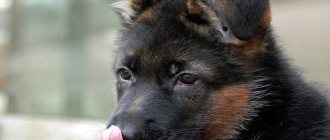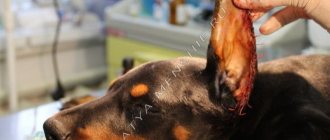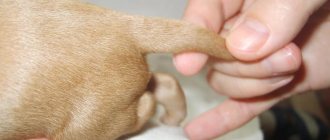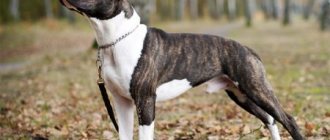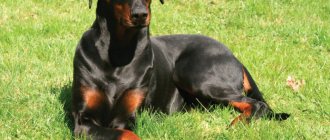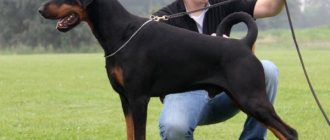Cropping a shepherd's ears is a procedure established by certain standards, which for certain species has a historical justification. Long drooping ears made the dogs vulnerable during fights with wild predators. The operation to shorten the ear is not performed on all shepherd breeds.
For dogs that do not herd herds or encounter predators in nature, this operation is optional and is purely cosmetic. Some species, such as the German Shepherd, for example, simply need to position their ears correctly so that they do not droop.
What is ear cropping in dogs?
Cupping is a partial or complete amputation of the ears. The length left depends on the standard assigned to the particular breed.
This operation began with the ancient Romans and Greeks, who shortened the ears of fighting and hunting dogs for safety purposes. Short ears were more difficult to grab with teeth or scratch with bushes. Amputation also reduced the risk of infection by mites and reduced the likelihood of inflammation due to insufficient ventilation of the ear canal.
Doberman
It was not nature that gave the Doberman long pointed ears; removing the loose soft part helps give them the desired shape. The standard provides for such an operation to obtain an invulnerable service dog. This is what the creator of the breed, Louis Doberman, wanted.
The procedure simplifies the care of the pet, makes it more intimidating, and eliminates the risk of injury in service. Ear cropping protects against rabies and reduces the risk of ear inflammation.
The optimal age of a puppy for surgery is 6-7 weeks. Approximately 2/5 of the shell area is cut off, taking into account the size of the head to achieve harmony. Correct ear position is guaranteed by bandages and clamps.
Feasibility of the procedure
Since the 20th century, most European countries have opposed the operation, banning it at the national level by signing a convention. Changes have been made to the established conformation of many breeds, easing the rules for taking part in a dog show. The natural shape of the ears was no longer a serious obstacle to receiving an honorary title, so the only argument in favor of amputation remained only medical indications.
Exterior of the breed
Folding ears have always been associated with good nature. Such a soft image does not fit at all with the Doberman and other fighting breeds. For this reason, proponents of cupping continue to support its appropriateness, citing aesthetics.
Health recommendations
Due to insufficient ear ventilation, fold-eared breeds often suffer from otitis media. These dogs have their ears cropped for preventive purposes. Surgery is also used in the presence of the following medical indications:
- multiple ulcerations that prevent self-regeneration of the skin;
- burns and mechanical injuries;
- necrotic formations;
- tumors.
Relaxations are also made for those who perform guard duty or help their master on the hunt. In addition to protecting against parasites and infections, short erect ears are much better at picking up sounds. This makes it easier to catch violators and chase prey.
Arguments against
Animal rights activists focus on the dangers of anesthesia, the painfulness of the procedure and possible complications characteristic of any surgical intervention. No less important is the partial loss of the means of communication, since locators on the head participate in the communication process along with the tail.
If you nevertheless decide to amputate for the sake of preserving the historically established exterior, make sure that your actions are legal. In some countries, cropped ears can be a serious reason for refusing to participate in an exhibition.
Cupping in the past and now
People began cropping dogs' tails and ears even before our era. In ancient times, various prejudices became the basis for this procedure. Thus, the Romans amputated the tips of the tail and ears of puppies, considering this a reliable remedy for rabies. In some countries, aristocrats forced commoners to cut the tails of their pets. In this way they tried to fight poaching: the absence of a tail supposedly prevented the dog from chasing game and made it unsuitable for hunting.
However, most often, on the contrary, the tails and ears were docked on hunting and fighting dogs. The shorter the protruding parts, the more difficult it is for the enemy to grab onto them in a fight and the lower the risk for the animal to get caught on something and be injured during the chase. This argument sounds more sensible than the previous ones, and is sometimes guided by it even today. But in fact, such dangers are greatly exaggerated. In particular, a large-scale study showed that only 0.23% of dogs suffer tail injuries.
Today, in most cases, cupping does not have any practical meaning and is only a cosmetic procedure. It is believed that this improves the exterior and makes the dogs more beautiful. According to proponents of docking, the operation creates a unique, recognizable appearance, helping the breed stand out among many others - and thereby contributes to its popularization and well-being.
What breeds need the procedure?
According to international standards, amputation is recommended for almost all working, hunting and fighting breeds. The main condition is that the ears are too long, unable to stand on their own from birth.
List of breeds
The most famous representatives include:
- miniature pinschers;
- American Staffordshire Terriers;
- alabai;
- Caucasian Shepherd Dogs;
- Cane Corso;
- pit bull terriers;
- boxers;
- Dobermans;
- Great Danes;
- toy terriers.
The recommended length and subsequent placement of cropped ears are different for these dogs. For this reason, it is very important to find an experienced veterinarian who is aware of all the nuances.
Features of cupping for each of them
Let's consider the main features of amputation for each of the previously listed breeds:
- miniature pinschers
. This miniature version of the Doberman is a decorative breed, so docking is used solely from an aesthetic point of view. It is carried out at 3 months. After removing the sutures, they resort to mandatory fixation with cotton swabs.
- American
Staffordshire Terriers
. Amstaffs are circumcised at 1.5-3 months, choosing the length depending on the animal’s field of activity. The maximum length is reserved for show pets, and the minimum length for working dogs. Amputated ears easily take the desired shape without an additional frame. - Alabai
. Representatives of this breed often suffer from heavy blood loss, so they are operated on within 3 days after birth. The shape is selected to be as short as possible, that is, no more than 1/3 of cartilage.
- Caucasian
Shepherd Dogs
. The recommended timing and form are similar to Alabai. Later intervention is not recommended, since manipulation of the hardened tissue often leads to complications. - Cane-Corso
. Using the procedure, hanging ears are turned into neat rounded triangles. They stand up very well on their own, but for reliability they are still fixed with adhesive tape.
- Pit bull terriers
. The methodology and recommended age are similar to amstaffs. It is better to sign up for surgery 2 weeks after vaccination.
- Boxers
. The final shape resembles horns, and the recommended age is 2 months.
- Dobermans
. Here it is recommended to do it before the onset of 2 months, that is, before the change of baby teeth. Only 2/5 of the animal’s ears are cut off, making sure to secure the shell with clamps and bandages.
- Great Danes
. Dogs are registered for docking at 2.5-4 months. They cut off 1.5-3 cm of the ear tissue and fix it all using a structure for Dobermans. The only difference is the size of the materials used.
- Toy Terriers
. Another decorative dog undergoing the procedure solely for aesthetic purposes. They are docked at 2 months, be sure to secure the cropped ears with a tight bandage for proper placement.
Despite some age differences, there is a limit that is the same for everyone - 4-6 months. We are talking about the upper limit when cutting becomes very painful due to the development of pain memory.
Pit bull terrier
The breed was bred for dog fighting. Today this is a rare occurrence, and the strongly built animals live in peace with humans.
Puppies are docked at the age of 1-2 weeks, usually leaving 1/3 of the original length of the ear. The fighting form has short shells, the exhibition form is very characteristic, with a corner bent inward.
The operation prevents ear necrosis, ulcers, injuries and neoplasms in pit bulls.
Until what age do dogs have their ears cropped?
The easiest time to undergo the operation is shortly after birth. Up to 2 weeks, babies are less sensitive to pain and do not remember it, and their tissues regenerate much faster. The only negative is increased bleeding.
After 4-6 months, the pain worsens, and large scars often remain at the site of circumcision. For this reason, the average age for ear cropping in dogs ranges from 2 weeks after birth to 3 months, and the maximum is 4-6 months. At a later age, amputation is resorted to only for medical reasons.
Schnauzers
The German tradition in relation to wire-haired schnauzers has always rejected lack of composure, promoted harmony and balance, and affirmed a clearly defined silhouette of the head and a “brick-shaped” muzzle. Ear cropping helped achieve such standards.
The correct operation creates an image chopped with an ax and gives a stern and wary appearance to this service breed. The procedure is carried out until the child reaches one year of age. After docking, the ears must be exposed.
Progress of the procedure step by step
The animal is operated on in a veterinary clinic or directly at home. Despite the attractiveness of the latter method, it is better not to resort to it. At home, it is more difficult to maintain sterility and provide first aid in case of complications.
The duration of the procedure takes 30-60 minutes. To crop dogs' ears, a pattern is used - a metal stencil that matches the required shape.
immediate docking begins
- The pattern is fixed to the shells using clamps to prevent bleeding.
- The excess part of the ear tissue is cut off with a scalpel. If there are large blood vessels, the edges of the wound are cauterized.
- The operated part is sutured, treated with antibiotics and a special healing glue.
The awakened pet is returned to the owner. The postoperative period lasts 7-10 days.
Docked tail: technology features
Tail docking - methods.
According to the latest breed standards issued by world organizations, more than a third of the total number of dogs are subject to tail docking to a certain length. There are two main tail docking technologies:
- tight elastic method - consists of tightening the tail with a tight loop at a certain level (the skin needs to be pulled back to the beginning - but in some breeds this is not so easy);
- circumcision method - performed with special scissors (the procedure is extremely simple: the tail is clamped, cut off and treated with an antiseptic).
The differences in the methods are visible and understandable - the first of them is completely bloodless, which makes any blood poisoning impossible: the tail simply stops being supplied with blood and dries out. According to the observations of specialists and breeders, a puppy has no problems with a drying tail - he simply does not notice it .
The second method is much more dangerous: there is a possibility of infection of the open wound. If the surgeon decides to sew up a wound on the tail, it is necessary to use anesthesia to avoid shock in the puppy. With this method of relief, proper care of the wound after surgery is important: despite the fact that the wound heals quite quickly, it is important not to tear off the resulting crust and not cause an infection.
ADVICE! After the tail docking procedure, the animal’s immunity decreases somewhat, so it is important to support it with a balanced diet and vitamins.
Caring for the animal after surgery
After cropping, the dog's ears are tightly bandaged, making correct positioning easier. A veterinary cone is used to protect against injury. Until the wounds heal, it is necessary to ensure that they are clean and the edges are dry. Otherwise, suppuration or deformation of the ears may occur.
Posting is done only after the stitches are removed. To do this, use a special massage and fixing structures made of cotton swabs and adhesive tape. While wearing such a corset, the ears gradually take the desired shape. Most often, production takes 14-20 days.
Boxers
There are no such dogs with floppy ears in nature. Docking for a boxer is not a whim, but a vital necessity.
This breed can have ears of different shapes and sizes. The situation is the same with thickness and density, positioning and turning. In any case, the ears should be in harmony with the Boxer's head.
The best age for surgery is 2.5-3.5 months. The standard provides for a sharp shape of the ears.
Possible complications
Complications do not always occur due to poor surgeon performance and careless postoperative care. Often the individual characteristics of the animal are to blame for their appearance. Possible consequences include:
- bleeding, fraught with heavy blood loss;
- large scarring that worsens the appearance of the ear;
- wound infection and subsequent inflammation, requiring repeated surgery.
If your dog’s health worsens, be sure to contact the veterinarian who performed the amputation. Remember that taking medications without a doctor's prescription is strictly prohibited.
Caucasian Shepherd Dog
This breed was created for protection. The operation is performed to protect the dog from infection if the animal is injured. Ear cropping is also necessary to create the dog’s characteristic appearance.
From the age of 3 months, puppies fight for territory and leadership. By six months, only rags remain from the auricle. When the puppy is strong enough, he is docked. There are no uniform patterns, because each animal has an individual head shape and ear structure. As a rule, the top part is cut off.
Is it possible to perform ear trimming at home?
Pruning is done strictly by a veterinarian. Carrying out the procedure by a person without the appropriate education can result in the death of the animal from excessive blood loss, incorrectly selected anesthesia, or sepsis due to insufficient disinfection.
Calling a surgeon to your home is possible, but it also carries a number of risks. To be safe, it is recommended to neglect the psychological comfort of the animal in a familiar environment and carry out the operation according to all the rules - in the clinic.
Approximate cost of the operation
The average price ranges from 300 to 1500 rubles. The final cost depends on the city, the prestige of the clinic, the level of qualifications of the veterinarian, the age of the pet, the complexity of the case and the need for a home visit.
Conclusion
It is necessary to crop a dog's ears with great care, since saving on this procedure can result in the death of the animal. If you do not plan to participate in exhibitions and breeding, then it is better to accept your pet as it is. Droopy ears will not affect behavior and other important qualities, so you should not tempt fate to conform to an ideal that has long lost its relevance.
The article is for informational purposes only. Contact your veterinarian!
Do you like the article? 420
How the process works
Tail docking for puppies is carried out in 2 ways: using a tight rubber band or cutting with scissors. The first option is less traumatic and is performed without anesthesia.
Drag method
The veterinarian pulls the baby's skin to the base of the tail, finds the desired vertebra and secures it tightly with an elastic band. This tourniquet stops the blood flow, so within 5-7 days the tip dries out and falls off. The risk of bleeding is minimal, so sepsis is practically excluded.
Circumcision method
After anesthesia is administered, the desired area is fixed with fingers and trimmed. To stop bleeding, the cut site is clamped for 2 minutes, and to prevent infection, it is treated with an antiseptic.
The skin stretched to the base is returned and sutured, applying a sterile bandage. A crust forms at the amputation site, which disappears after 20-30 days.
